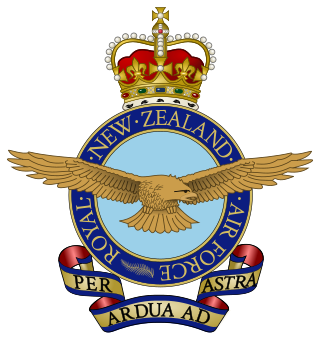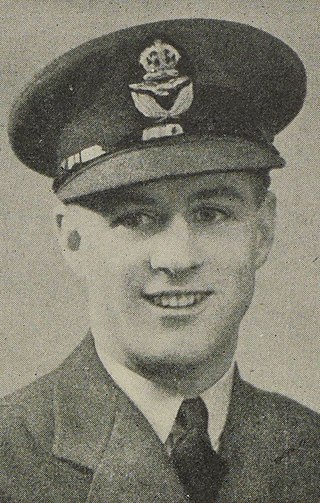
The Royal New Zealand Air Force is the aerial service branch of the New Zealand Defence Force. It was formed initially in 1923 as a branch of the New Zealand Army, being known as the New Zealand Permanent Air Force, becoming an independent air force on 1 April 1937.

Mount Taranaki is a dormant stratovolcano in the Taranaki region on the west coast of New Zealand's North Island. At 2,518 metres (8,261 ft), it is the second highest mountain in the North Island, after Mount Ruapehu. It has a secondary cone, Fanthams Peak, 1,966 metres (6,450 ft), on its south side.

The Airspeed AS.10 Oxford is a twin-engine monoplane aircraft developed and manufactured by Airspeed. It saw widespread use for training British Commonwealth aircrews in navigation, radio-operating, bombing and gunnery roles throughout the Second World War.

The Handley Page HP.67 Hastings is a retired British troop-carrier and freight transport aircraft designed and manufactured by aviation company Handley Page for the Royal Air Force (RAF). Upon its introduction to service during September 1948, the Hastings was the largest transport plane ever designed for the service.

James Allen Ward, VC was a New Zealand aviator and a recipient of the Victoria Cross (VC), the highest award for gallantry "in the face of the enemy" that could be awarded at the time to personnel of the British and Commonwealth forces.
New Zealand National Airways Corporation, popularly known as NAC, established by the New Zealand National Airways Act, 1945, was the national domestic airline of New Zealand until 1978 when it amalgamated with New Zealand's international airline, Air New Zealand. The airline was headquartered in Wellington.
No. 75 Squadron of the Royal Air Force operated as a bomber unit in World War II, before being transferred to the Royal New Zealand Air Force in 1945. This remains the only time in RAF’s history that a squadron was gifted to another commonwealth Air Force.

No. 25 Squadron of the Royal New Zealand Air Force was formed at Seagrove, Auckland in July 1943 with Douglas SBD Dauntless dive bombers and served in the Southern Pacific based at the Piva Airstrip on Bougainville, flying missions against Japanese forces on Bougainville and at Rabaul. It was disbanded in May 1944 and reformed as a fighter/ground attack squadron flying F4U Corsairs. It served in Santo, Guadalcanal, Los Negros and Emirau, before returning to New Zealand and being disbanded in September 1945. A SBD-4 Dauntless operated by 25 Squadron was for a time preserved in the Royal New Zealand Air Force Museum at Wigram, displayed in the condition which it was recovered after being lost with its crew while on a training mission at Espiritu Santo. One of the SBD-5 aircraft operated by 25 Squadron has been restored to flying condition in America for the "Planes of Fame" museum, in the colour scheme of an American aircraft.

Ardmore Airport is an airport 3 nautical miles (5.5 km) southeast of Manurewa in Auckland, New Zealand.

The Fairey Gordon was a British light bomber and utility aircraft of the 1930s.

The Airspeed Consul is a twin-engined light transport aircraft and affordable airliner designed and produced by the British aircraft manufacturer Airspeed Limited. Introduced during the immediate post-war period, it was a straightforward conversion of surplus Airspeed Oxford military trainers that had been extensively used during the Second World War.
BOAC Flight 911 was a round-the-world flight operated by the British Overseas Airways Corporation (BOAC) that crashed near Mount Fuji in Japan on 5 March 1966, with the loss of all 113 passengers and 11 crew members. The Boeing 707 jetliner involved disintegrated mid-air shortly after departing from Tokyo, as a result of severe clear-air turbulence.
The Royal Air Force (RAF) and Fleet Air Arm had included personnel from outside the United Kingdom from before the beginning of the Second World War, and many served in the Battle of Britain in summer 1940. Many of these volunteers were British subjects—thus, citizens—coming from territories that made up part of the British Empire. Additionally, a significant part was made up of refugees and exiles from German-occupied Europe and American emigrants.

Dive Bomber is a 1941 American aviation film from Warner Bros. Pictures, directed by Michael Curtiz, and starring Errol Flynn and Fred MacMurray. The film is notable for both its Technicolor photography of pre-World War II United States Navy aircraft and as a historical document of the U.S. in 1941. This includes the aircraft carrier USS Enterprise, one of the best-known U.S. warships of World War II.

Walter Symes was a Liberal Party Member of Parliament in New Zealand.
The Dawson Farm aerodrome was located at Myross Bush, New Zealand, northeast of the southern city of Invercargill. As the name suggests, the airfield was created by a local farming family for the eventual development into Invercargill's first public aerodrome in 1929. Local aviation enthusiasts as well as national aviation personalities such as George Bolt were visitors, bringing the still rare sight of aircraft into the region. At the time it was located a considerable distance from the town centre and city officials opted for a closer site, building a new airport on reclaimed land in the New River estuary in 1939, now today's Invercargill Airport. This was to encourage commercial services.

No. 485 (NZ) Squadron was a fighter squadron established for service during the Second World War. It was the first New Zealand squadron formed under Article XV of the Empire Air Training Plan. Although many of its flying personnel were largely drawn from the Royal New Zealand Air Force, the squadron served in Europe under the operational and administrative command of the Royal Air Force.

Antonio Simmons Dini was a New Zealand fighter pilot and flying ace who flew in the Royal Air Force (RAF) during the Second World War. He is credited with at least five aerial victories.













